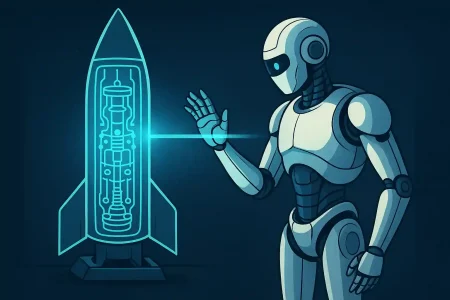One of the secrets to building the world’s most powerful computer is probably perched by your bathroom sink.
Before we get into the inexplicable reason quantum computers, the bleeding edge of human technology, require dental floss to operate, let’s briefly look at what quantum computers actually are. As opposed to regular computers that rely on the principles of Boolean algebra, quantum computers are based on the principles of quantum theory like quantum superpositioning and quantum entanglement.
The difference is that while regular computers use bits as the fundamental units of data that can be represented as 0s or 1s, quantum computers use qubits (pronounced CUE-bits) which can be either 0s, 1s, or both together at the same time (superpositioning). So while regular “bits” are constrained by the need to be a 0 or a 1, quantum computers have no such limitations.
This is basically because bits pass through logic gates made up of transistors that act like switches and represent 0s and 1s by either being “on” or “off.” In contrast, qubits can be represented by semiconducting circuits, photons with polarization, electrons with spin, or trapped ions, each representing a different value combination.
This is why a single qubit can hold 4 different value combinations, 0 and 1, 1 and 0, 0 and 0, or 1 and 1. This gives them exponentially more computing power than regular computers, allowing them to process infinitely more information in a given time frame. In addition to being able to be in 2 states at the same time, qubits can also form special relationships with each other.
Absolute zero

This is called quantum entanglement where the state of one affects the state of the other irrespective of the distance between them. So while superpositioning is used to represent the state of different qubits, entanglement is what helps correlate those qubits to each other in order to perform complex mathematical operations in parallel and at much greater speeds than regular computers.
Now that we have that out of the way, let’s talk about why these machines need dental floss to run. Well, if you look at any of the quantum computers that exist today like any of the 20 machines that IBM, the leader in the field has, you’re going to be looking at what looks like a metal drum.
This is because the quantum computers that have been built so far require a temperature of approximately absolute zero to function as intended due to the fragile nature of qubits. If you’re thinking “oh that’s easy, my freezer goes way below zero, think again.” Absolute zero is –273.14°C or – 459.67°F, so the metal canister or drum that houses the quantum computer is part of the cooling system, and the shell that keeps the freeze in and the heat out.
If you do manage to get the shell off, what you’re now going to be looking at is nothing that resembles any computers you have seen before. The best description online is one that calls it “a chandelier of looping silver wires,” which is pretty accurate.
Dental floss

If you’ve ever run a very large server setup, you would know how important zip ties are and what a complete mess your life would be without them. The problem with a computer running at absolute zero is that most materials that could help you secure cables and avoid a mess of crisscrossing wires are going to go brittle and break at those temperatures.
Charlie Campbell of Time magazine writes “one of the secrets to building the world’s most powerful computer is probably perched by your bathroom sink.” That’s right, dental floss maintains its integrity at –273°C and is the preferred choice for Quantum scientists as a cable harness. “But only the unwaxed, unflavored kind,” to quote Jay Gambetta, IBM’s vice president of quantum.
Now while dental floss is an unlikely and completely out-of-the-box solution to the obstacle of harnessing wires at near absolute zero temperature, there are other obstacles. According to John Martinis, a professor of physics at the University of California, Santa Barbara, gate errors are the next big obstacle which for some reason isn’t getting the attention he feels it deserves. To quote him, “I think gate errors are way more important than the number of qubits at this time.” He then goes on to explain that it doesn’t matter if you have a 27 qubit chip or a 127 qubit chip if the qubits aren’t working the way they’re supposed to, which is below 1% gate errors.
The road ahead
In conclusion, quantum computers hold immense promise in fields that require exponentially more computing capability than exists today like AI, machine learning, aviation, astronomy, and even autonomous vehicles. In a recent report by NASSCOM, it is estimated that quantum technologies can add $310 billion to the Indian economy over the next seven years which explains why the Indian government has allocated over ₹8,000 crores to the National Mission on Quantum technology.
Like any new adventure, however, there are still a lot of known and unknown obstacles that have to be “dental flossed” out of the way.
In case you missed:
- Schrödinger’s Cat Just Made Quantum Computers 160x More Reliable!
- Humans Just Achieved Teleportation? Clickbait vs. Facts
- Quantum Computers: It’s now 20X easier to crack Bitcoin encryption than we thought!
- From Fridge to Fusion Reactor, How Mayonnaise is Facilitating Nuclear Fusion
- Mainstream AI workloads too resource-hungry? Try Hala Point, Intel’s largest Neuromorphic computer
- This computer uses human brain cells and runs on Dopamine!
- Lab-Grown Brain Thinks It’s a Butterfly: Proof We’re in a Simulation?
- Scientists establish two-way Lucid Dream communication!
- Researchers develop solar cells to charge phones through their screens
- Training AI for Pennies on the Dollar: Are DeepSeek’s Costs Being Undersold?









